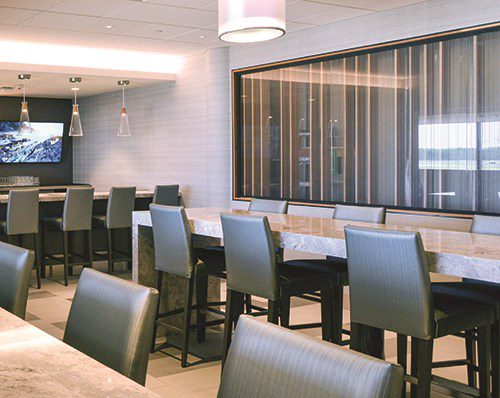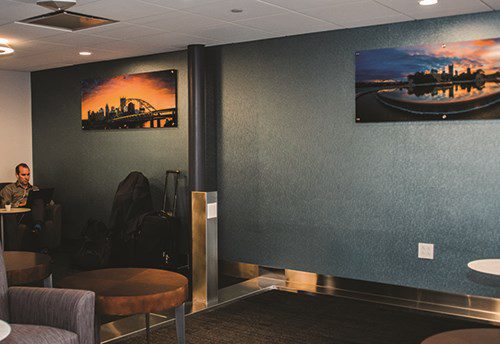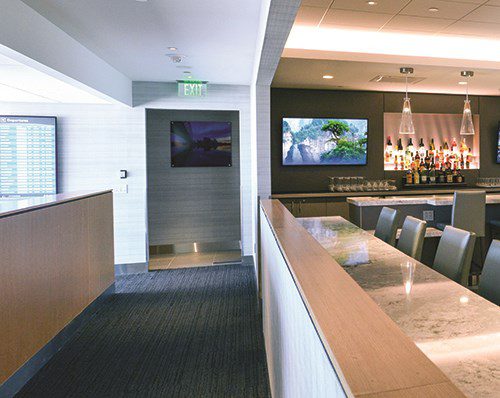An updated common-use lounge at Pittsburgh International Airport (PIT) is now even better equipped to offer first-class treatment to more passengers. In June, The Club at Pittsburgh International doubled in size and gained 60% more seating capacity.
An updated common-use lounge at Pittsburgh International Airport (PIT) is now even better equipped to offer first-class treatment to more passengers. In June, The Club at Pittsburgh International doubled in size and gained 60% more seating capacity.
 “It’s so rewarding to be able to offer a premium experience at an affordable price to every single passenger,” says Kim Kitko, the airport’s vice president of business development. “Anything we can offer that can help travelers relax and enjoy their time at the airport is a win-win for everybody. We want passengers to look forward to their time at the airport and consider it a good start to their trip, not a stress point on their journey.”
“It’s so rewarding to be able to offer a premium experience at an affordable price to every single passenger,” says Kim Kitko, the airport’s vice president of business development. “Anything we can offer that can help travelers relax and enjoy their time at the airport is a win-win for everybody. We want passengers to look forward to their time at the airport and consider it a good start to their trip, not a stress point on their journey.”
Airport Dimensions, which operates the lounge under a 10-year lease with master concessionaire Fraport, funded and executed the recent expansion and renovation project.
|
facts&figures Project: Lounge Expansion/Renovation Location: Pittsburgh Int’l Airport Format: Common-use/open to all passengers; standard admission price is $40/day – $34/day for AAA cardholders; access for Priority Pass members, which includes Priority Pass, LoungeKey & Lounge Club Lounge Operator: Airport Dimensions (formerly Airport Lounge Development) Master Concessionaire: Fraport Lounge Size: 4,657 sq. ft. Seating Capacity: 102 Construction/Renovations: June 2019 |
When the private operator first opened a common-use lounge at PIT in June 2017, it was a 34-seat facility in a temporary location previously occupied by a British Airways lounge. With Condor Airlines beginning service at PIT, the airport needed a larger lounge faster than one could be built. So a few months later, Airport Dimensions (then known as Airport Lounge Development) opened a new lounge with 41 seats; but that also quickly proved to be undersized.
Kitko describes the interest in and use of the common-use lounge as explosive. “Growth in traffic for The Club exceeds our growth in passenger traffic,” she comments. “People are discovering this amenity, liking it and using it at a higher rate than we initially thought.”
In May 2019, prior to the expansion, the lounge averaged 9,100 monthly users—about double the amount predicted by Airport Dimensions.
Since the new space opened, it has averaged
9,800 users each month. “It’s a nice amenity to have access to,” Kitko remarks. “The demand is there, and our numbers certainly show that.”
Nancy Knipp, senior vice president with Airport Dimensions, notes that guest volume has increased more than 390% since the lounge originally opened in summer 2017. “We are delighted with the significant growth in demand for The Club at Pittsburgh International Airport,” says Knipp.
“The airport’s continued enplanement growth combined with the increasing demand from the world’s largest lounge membership audience, Priority Pass, has validated the importance of the The Club for travelers at the airport.”

In 2018, PIT served 9.7 million passengers—about 7.5% more than in 2017. Through the end of October 2019, air traffic was up 1.5% over the previous year.
Premium Experience
The recent project doubled the size of the previous lounge to 4,657 square feet. The newly renovated facility features sweeping views of the airfield and seating for 102 people. All-inclusive amenities include a self-serve buffet with hot and cold entrees inspired by a local chef and a full-service bar.

“I think all airports are looking for ways to enhance the travel experience—in particular to reduce the anxiety for passengers,” remarks Kitko.
While relatively new to the United States, common-use lounges are very popular abroad, she notes. “Travelers coming in from other places in the world expect to have a shared-use offering.”
Management at PIT requested specific upgrades for the lounge: additional bathrooms and showers, more television screens and a greater variety of seating options for different types of travelers using the lounge.
In addition, Airport Dimensions used seating and amenities to establish specific areas to accommodate guests’ varied uses and preferences. For instance, the productivity zone, designed with the business traveler in mind, includes desks with power for laptops and other electronics; while the replenish zone features food and beverage options. The privacy zone, which is outfitted for guests who want to read or relax, includes a space similar to a phone booth for conducting private calls. Elsewhere, there’s a cell-free zone.
 “We designate these areas not so much by walls, but by different seating, which guides guests to their preferred area of the lounge,” Knipp explains. Tall-backed “privacy chairs” provide seclusion and noise barriers; banquettes facilitate dining; and a combination of high bar seating and dining tables is designed to be decidedly social.
“We designate these areas not so much by walls, but by different seating, which guides guests to their preferred area of the lounge,” Knipp explains. Tall-backed “privacy chairs” provide seclusion and noise barriers; banquettes facilitate dining; and a combination of high bar seating and dining tables is designed to be decidedly social.
“People have so many different expectations and needs on their journey through the airport,” Kitko notes. “For business travelers, the ability to conduct a conference call or meeting is a tremendous benefit to productivity. For leisure travelers, vacation can begin as soon as they get to the airport.
“Our lounge is a great way they can have a luxury experience for only $40 per day—$34 with a AAA membership card,” she says.
The Club at Pittsburgh International operates from 4 a.m. to 9 p.m. daily, and is available to Priority Pass members, which includes Priority Pass, LoungeKey and Lounge Club.
“Each of our lounges is uniquely different and reflects the city and community as well as the airport itself,” Knipp adds. “We offer similar amenities and signatures areas in each location, but the look and feel of the amenities are unique to each city.”

Local photography helps set the stage. At PIT, the lounge is decorated with works from Pittsburgh artist and photographer J.P. Diroll.
Easy Expansion
Thanks to careful programming, the expansion and remodel had little impact on existing lounge operations. “I never received a complaint throughout the process,” Kitko reports. “It was smooth and seamless, and [Airport Dimensions] stuck to a very good schedule.”
PIT relocated its Kidsport children’s play area before the lounge project began. Because of an existing wall that separated the lounge and Kidsport areas, much of the construction occurred without impact to the existing operation. Work crews dismantled the wall after hours to integrate the new space into the existing lounge.
“We do all possible to ensure that expansion or refurbishment to an existing lounge has the least impact on our lounge guests,” notes Knipp. “Working with the Pittsburgh International Airport staff, we were able to complete our expansion without interruption or inconvenience to our lounge.”
Prior to the project at PIT, Airport Dimensions rolled out a new cocktail program across its entire U.S. network. Featured drinks include Brew City Margarita, The Lounger and The Vineyard G&T. “Planning for the expansion of the lounge at Pittsburgh International, we recognized that we could enhance the guests’ experience with a bar that featured our signature cocktails,” explains Knipp. “Guests love the ability to relax at a bar if they don’t want to work or rest; and it allowed us to showcase our new cocktails.”

Concessions Collaboration
“We want to identify the best practices and best passenger experiences from around the world,” says Kitko. To do so, she studies wider hospitality trends, not just airports.
“I think saying that passengers are a captive audience is absolutely false,” she emphasizes. “We have to provide the right things to the passengers at the right time.”
Airport Dimensions urges airport operators not to underestimate how much passengers value a shared lounge. “We conduct significant analysis to forecast out guest volumes,” says Knipp. “We draw upon over 13 years of experience operating shared-use lounges at U.S. airports to develop our projections. We have gained a solid reputation for outperforming our guest projections because of the unprecedented growth of the Priority Pass membership audience.”
Working closely with airports to track enplanement and passenger trends is critical to the process. “As the lounge operator, it is important that we have clear sight into what the airport believes its growth will be in flights and airlines in the coming years, in order to project the appropriate size and seating requirements of the lounge,” says Knipp.
Digging deeper, the Airport Dimensions team considers each airport’s traveler demographic to determine space allocation and design for its lounge. “A market like Pittsburgh has quite a bit of business travelers, so we tend to put more seating in an area where people would be traveling alone and might want to do more work,” she says. “We plan the lounge seating to adapt to the behavior of travelers.”
Airport Dimensions, owned by Collinson, specializes in the design/construction, operation, management and marketing of independent shared-use airport lounges. It currently operates 19 locations in the U.S. and four in the U.K.
In 2020, the company plans to expand into other airport amenities such a sleep pods and video gaming lounges.



